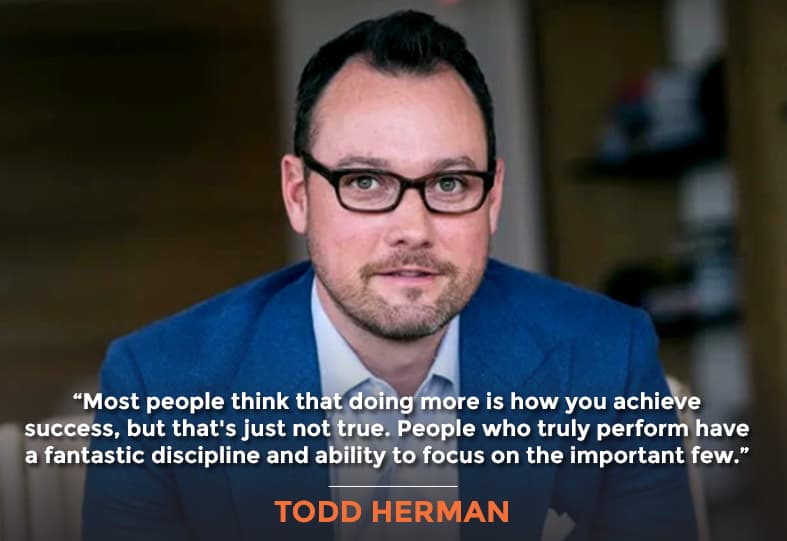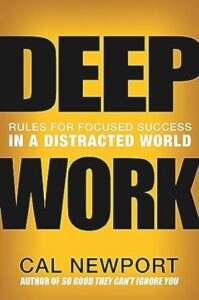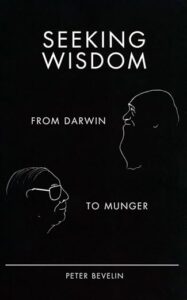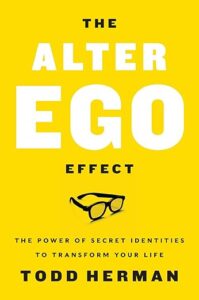Annual goals? Five-year plans? Science says they’re setting you up to fail. Research shows that any goal beyond 90 days triggers massive procrastination—especially for entrepreneurs, who statistically have higher rates of ADHD and need shorter timelines to stay focused.
Todd Herman, my guest on today’s show, created the 90 Day Year system after working with Olympic athletes and Fortune 500 companies for over two decades. His secret? One goal. That’s it. Not three. Not five. One.
In our conversation, Todd explains why most people confuse projects with goals and how that confusion kills momentum. We discuss the hidden cost of juggling multiple goals and how context-switching can actually drain 20% of your workday. Todd shares the conversation he had with Mark Zuckerberg about Facebook’s fanatical focus on one objective—get more users—and how that singular focus fueled their explosive growth. He reveals the OPP Framework for identifying what actually matters versus the busy work that keeps you spinning. We also get into themed workdays, strategic calendar blocking, and why meditation is the bicep curl for your brain’s focus muscle.
This episode originally aired on Get Yourself Optimized, but every insight applies to marketing effectiveness and business momentum. So, without any further ado, on with the show!

In This Episode
- [02:26] – Todd Herman shares the origin of the 90-Day Year system, which started with a 13-year-old hockey player and evolved into a high-performance system for athletes and entrepreneurs.
- [08:42] – Todd introduces the OPP framework: Outcome, Performance, and Process.
- [14:52] – Todd differentiates between goals and projects, emphasizing that goals create accountability.
- [23:56] – Todd helps listeners visualize what the 90-Day Year system looks like for goal setting and goal achievement.
- [35:13] – Todd shares tips for managing meetings and ensuring that they are productive and efficient.
- [49:48] – Todd discusses the concept of theme days, where different tasks are scheduled for specific days of the week.
- [52:02] – Todd talks about the concept of alter egos and secret identities, which he uses to help athletes and entrepreneurs perform better.
- [54:32] – Todd provides information on where listeners can learn more about the 90-Day Year system.
Todd, it’s great to have you on the show.
Mr. Spencer, it’s a pleasure, my man.
Well, I’ve been wanting to have you on for a while now. We met multiple years ago now at Taki Moore’s Black Belt Program, and I just finally got a chance to attend your 90 Day Year live event, which was awesome. Why don’t we start by telling the listeners all about the concept of the 90 Day Year?
Well, my world has been in high-level athletics for the last 21 years. I’ve been in the sports performance and sports science research company for a long time, and I’ve been working with athletes on the mental game and high performance, and along that process of trying to get athletes to perform consistently. Because that’s always the number one recurring theme that comes up, is just, “How can I be more consistent?” That’s also something that coaches always bring up. Every coach wants that athlete who’s just going to perform for them consistently. It’s like building predictability into their system. It was just, “How can I help my athletes?” Find that zone and flow state more consistently, but then also, even when they can’t find the zone and flow state, how can they get the maximum capabilities out of themselves and over the course of time, just this system of getting athletes.
Well, here’s the big problem. I was sitting down, telling someone this story the other day about where the 90 Day Year actually started: in a kitchen table in Saint Albert, Alberta, Canada. I was living in Edmonton at the time. I live here in New York City right now. I was sitting down with a 13-year-old and we’re mapping out his season. He’s a hockey player during the hockey season and a baseball player during the baseball season, and he plays many different sports. They run for a very long time, and you always get this leg that happens in the middle of the season. We call it the long slog or the middle slog. I just said to him, “Why don’t we just break this up into two 90-day sprints?” Sprints are just a concept we talk about a lot in sports, and so we broke it up into 90-day sprints, and that’s actually where this system first started. It was all just around high performance, just getting people to perform consistently. Over time, that system became quite popular in sports, and then I was introduced into the corporate world.
Focus on the important things that will actually get you to the next stage of your business, the few things that will actually grow your business, or the few things that will truly advance your brand or product to the next level.
I was sitting down and talking to an executive at Chevron, a big oil and gas company, and he had said, “Listen, we want to bring your 90-day thing in here. We don’t really talk about sprints, though. Can we change it into something different?” He was like, “Why the name?” I explained it, and I said, “Well, why don’t we call it the 90 Day Year?” He was actually the one who gave it the name. I was like, “I like that name,” and that was in 2003. That’s where it all started. The 90 Day Year for entrepreneurs is just installing a high-performance system into your business. Most people think that doing more is how you achieve, and it’s just not the truth. People who truly perform and meet those consistent levels of performance have a fantastic discipline and ability to focus on the important few things that will actually get you to the next stage of your business, the few things that will actually grow your business, or the few things that will truly advance your brand or product to the next level. The 90 Day Year is a system to help you actually find that and, more importantly, go and execute on it.
Every coach wants that athlete who’s just going to consistently perform for them. It’s like building predictability into their system.
How do you differentiate between the crucial few and the trivial many?
Well, we have a system and an assessment. We use a model to help people find that. I have a common phrase that I use with clients and people in my world. You hear me talk about it all the time, but I always bring up the “field of play”. What I mean is the field of play is just that place where you’re truly out there, executing this. It’s that place where the action happens. There are a lot of people who stand on the sidelines of life, and they’re fantastic prognosticators and predictors and armchair quarterbacks, telling you what should work and could work. Just by the fact that they’ve never been on the field of play, it’s like those people who tell you how to go and tackle when they’ve never actually tackled anybody in their life.
Don’t you just love how you get relationship advice from people who are currently going through a divorce, and people who give you business advice or financial advice, and whose business or finances are crumbling? I just love that.
That’s a discussion for a series of podcasts that we could get into. When I talked about the field of play, I always explained to people that when you look at success, I’ve worked with hundreds of pro and Olympic athletes. I’ve worked with extraordinarily successful entrepreneurs, billionaires, and major corporate leaders. When you take a look at, in hindsight, the 20-20 of how many people got there, it was a sequencing. Many people got there because they did the right things at the right time in the right sequence. I talk about sequencing a lot. When I’m talking about this whole field of plaything, and when you say, “How do you focus on the few instead of the trivial many?” it’s, first, “What stage of business are you in?”
I guess we’re talking to, most likely, a lot of entrepreneurs. When you know the stage of business that you’re at–are you in startup, that first stage of business–well, there’s really only a couple of activities that you really, truly need to be focused on at that stage. That stage is all about validating your product or validating the service that you have like, “Do people actually want this thing?” and, “Are you validating the audience and are you choosing a niche that you’re going to be going after?” because the thing that holds people back here is this idea of, “Well, everyone should need and want what I have,” or they go after this general group of people instead of really dialing in and focusing in on just a few people. That’s just your starter group.
It’s really hard to build a marketing system or a sales system around an unclear product, service, or group of people that you’re trying to market to.
That’s your starter market. That doesn’t need to be your forever market; it’s just your starter market. It just gets you in the game, so to speak, but that whole stage of business is about validating. You’ve got to validate. Many people go off and start jumping around on marketing and sales systems. Well, it’s really hard to build a marketing system or a sales system around an unclear product, service, or group of people that you’re trying to market to. There are more people who actually might have quite a bit of revenue coming into their business, but I would still classify them as starters because they still have not identified. There may be very good marketers or something like that, but they still have not identified what their product or service is.
You could have somebody who’s focused too early on things like messenger bots. They don’t even know what their value proposition is or the true pain points that their target audience is experiencing, and so the messaging isn’t quite right, even though they got some really cool tools in place.
That’s probably one of the most relevant and perfect examples to give right now, jumping on a bunch of tools when you don’t even know who it is that you’re talking to. That gets back down to the critical few versus the trivial many. That is a great tool. It’s a great strategy to use only if you’re putting it in the sequence properly. If you’re putting it out of sequence, you’re just delaying the amount of time that you’re going to be able to reach success.
Through the process of the 90 Day Year, you would identify that it would be just a shiny object that is not going to truly produce a result for you, because in the world of high performance, there are really three phases to high performance. There’s the performance phase, there’s the achievement phase, and there’s the execution phase. The 90 Day Year encompasses all of those phases in the way that the system is built, and each one of those phases actually maps to time. Performance is a past-tense thing. It’s not a future tense, and it’s not a present tense because anytime you’re referring to performance, it’s always in the past tense. “How did you perform?” “How are you performing?”
Well, you can only answer those questions by referring to it in the past tense. In order for you to really give a good assessment of how you’re performing, you’ve got to have data. That’s why we have a support science business; it’s a science business. Nothing that I teach is ever anecdotal. I think most of the people who are listening may have graduated and are past the whole idea of anecdotal success. “Hey, I did it and so you can, too!” That’s a claim that is best-suited for the 1990s, not for the present tense. I think we can demand a little bit more from the systems that we’re using. That’s why we put people through an assessment based on the stages of business that you’re in for our entrepreneurs. For the sports clients, we have them go through an assessment on the seven core pillars of mental toughness.
For you to really give a good assessment of how you’re performing, you’ve got to have data. That’s why we have a support science business.
In the corporate leadership world, we have them go through the five principles of leadership. We assess and get the data, and then, from that, it helps to build clarity so that you can then get into this next phase, which is the achievement phase. Now, we’re going to skip to the future tense. “Where are you going? What’s that mission that you’re on, that vision that you’ve got, or that purpose that you’re on?” We call it the MVP. “What’s the MVP of your future?” and so we build that out.
Then, from that–because now we’ve connected these two polar opposites, the past and the future–now we can fill in with this next phase of achievement planning out what your 90-day goal is. Any goal should only be 90 days out. It’s not a year away. It’s not three years away. It’s 90 days out, and there’s a lot of science behind why we do this. There have been many studies. The University of California, Santa Barbara, Stanford and the University of Waterloo in Canada have done research around procrastination and avoidance behavior.
Any goal or project that goes beyond 90 days tends to create high levels of avoidant behavior. When you take a look, typically, at the personality makeup of most entrepreneurs, there’s a higher percentage of ADHD and dyslexia in the world of entrepreneurship than in any other vocation. The 90 Day Year is almost custom-built to help entrepreneurs stay focused and achieve the growth that they’re looking for. We move on to the goals, and then we figure out what their strategy is: “What are those projects you’re going to be working on in the next 90 days to help you achieve the field of play goal that you’re on?” We’ve already, through this model, helped you strip away the things you should never even be thinking about and stay focused on what you should be working on. That way, with this system, we end up with graduating people through the stages of business far more quickly.
Then, finally, we work on the execution phase, and this is actually the stuff that most people are more familiar with. This is where productivity sits. That’s why productivity in and of itself, while it’s important, is never the solution if you’re caught up in working on too many things and you don’t know exactly what you should be working on. Productivity is an after. It’s not a cause; it’s more of an effect of the previous two. Then, we get down to execution, and that comes down to “What are the routines and habits that you’re building into your business? What are the routines that you have that you’re working on daily?” Our field of play as entrepreneurs or business professionals is always based on–I take a look at someone’s calendar. When I see someone’s calendar, I can tell whether or not they’re getting the results that they should be getting because that should be truly our field of play, where our activities go. It’s the way that we are managing the resources that we have, and so we really focus on that in The 90 Day Year or build systems around you to help make that happen for you.
I’d be curious to see what you come up with if you look at my calendar. How fast are you able to assess if somebody’s productive or spinning their wheels, like 10 seconds? Is it that fast for you?

I guess it would just depend on when I’m meeting them. If we met at a rooftop lounge here in New York City and we were chatting for a little bit, it wouldn’t take about a few more minutes of me asking a couple of questions, whether or not there’s a lot of performance leakage in someone’s world. The fastest place to find it is always in whether or not people have real clarity around what they’re doing. If they don’t know where they’re going or what their number one goal is right now, then I know for a fact that I can give you any tip on managing your calendar better, and it’s not going to make much of a difference. You’re going to walk away because you’ve got this good tactic made and feel good in the moment, but fundamentally, the actual problem hasn’t been solved.
If you are not super-clear on what your number one goal is for these next 90 days or whatever your time period is, but 90 days is ideal as far as the best time period, then you’re probably spinning your wheels and aren’t very effective. Now, what if you have three goals or five goals, and you haven’t distinguished which one of those five is super important to you? They’re all important. Also ineffective?
100%. We have one overarching goal for our 90 Day Year. Now, if you’re running a bigger organization, if you’re a one-person show and you’ve got three goals for your business, you’re ineffective. 100% you are. We just have enough data, even the people who come into The 90 Day Year, and they defy and want to break the system. They decided to get up to two, three or four goals, and then when we do follow-ups afterward on the success rates of people who had one goal that they worked on versus three or four, the success rate is just vastly different between them.
Our field of play as entrepreneurs or business professionals is always based on taking a look at someone’s calendar.
We distinguish between goals and projects because most people, with the things that they’re working on, think it’s a goal, but really, it’s just a project. A goal creates accountability. That’s what that creates. It’s holding you accountable to an outcome that is crucial to your growth and the path you’re trying to move towards. Projects are simply the ways you’re going to devote your resources in order to achieve that. For example, most people think, “I want to have a website,” and they think that having a website is a goal. It’s not; it’s a project.
Here’s how I know it’s a project because there’s really nothing there that has been made accountable to that website, bringing something of value back to you. If you had changed it to, “We’re creating a website that is going to be bringing in $50,000.00 a month in leveraged income from product sales,” now that’s a goal. You changed the project into a goal, but a website in and of itself is simply a project.
There aren’t that many goals in business. I think we’ve mapped out, in total, about 15 goals that you could really ever have in business because goals are always a lagging indicator. Winning the gold medal at the Olympics is a lagging indicator. It’s because of something else that helped make that happen. There are hundreds, upon hundreds, upon hundreds of projects or ways that you could go about achieving that goal, always dependent upon the type of business that you’re in, the type of products and services that you offer, your business model, and your geographic location, possibly as well. While most people think they’ve got a lot of goals, really, they don’t. They just have a lot of projects that they’re working on. If you fundamentally took a look at why you’re doing those projects or why you’re doing those things, it’s because you wanted to impact something financially or something from a time perspective.
What would be some of these 15 or so goals that you’ve identified as being the main goals that businesses have or individuals within the business?
Some of the most popular ones are always going to be a revenue, sales, or profit goal that you would have inside your business. Another one could be something around your marketing channels and the number of leads or prospects that you’d be getting into your business.
The quality of those.
Exactly, or the quality of them. Another goal might be simply validating something. We’ve started mapping the goals directly to the stages of business to help people achieve faster results within The 90 Day Year, so that you can take a look at the startup stage of business. Like we’ve talked about before. You’re only doing a couple of activities in the startup stage, and you’re either validating your product or you’re validating the niche or the audience that you’re going into. You can have a goal around that.
You’re only doing a couple of activities in the startup stage, and you’re either validating your product or you’re validating the niche or the audience that you’re going into.
In the next 30 days, we will be able to validate whether or not we’re going to move forward on XYZ product after we’ve validated 18% of the target audience wants this product, something along those lines and/or you could have a role around operations, reducing costs inside of your business or reducing the amount of time, as a business owner, you’ve been spending inside the business.
Even the people who are out of this thing right now, if they’re in a place where they really need to hire somebody, they really want to bring in some help, you want to be mapping the purpose of that hire to a goal. Why are you actually bringing in that person here? I’ll give you an example. Last year, I was bringing in a head of operations for one of my businesses, and I had mapped that to the goal of reducing the number of hours worked in that business by 25% by XYZ date. Then, I held that head of operations accountable to that goal. If I’m working 30 hours a week inside that business and I want to pull 25% of my time away from that business, now, I’m looking at reducing myself down to roughly 23 hours a week in that business. She needs to make sure that we’re building up systems and removing me from seven hours’ worth of work in that business. Now, we have a date attached to it.
Developing systems that you might be doing, those are projects; those aren’t the goal.
Again, some of this stuff can just be semantics for some people, but what’s important is if you have too many goals, you just build up way too much what we call context-switching or task transference in the brain. Every time you move from project to project, or task to task, or you’re focusing on so many goals when you’re a solo operator, or you’re a small team. Every time someone refocuses their attention on a new goal or another project, they have to recalibrate. “Where was I working again? And what’s going on with this?” The more you do that throughout the day or throughout the week, you actually lose time.
Gerald Weinberg did a study on this back in the early 1990s and found that basically moving from one task to another task caused you to lose about 20% of your time in your day. If you’re constantly moving back and forth between two tasks, two activities, two projects at the same time, you’re losing 20% of your day. The last time I checked, most people were asking for more time. That’s one of my promises that I give people when it comes to high performance. I’m literally not going to ask you to do, truly, anything different in your life, and I can give you back time just by simply getting you to run this particular system that we have.
People who think that they can accomplish a lot by jumping back and forth, that they can multitask, that’s a complete fallacy, right?
Any goal or project that extends beyond 90 days tends to create high levels of avoidant behavior. So, the 90 Day Year system is custom-built to help entrepreneurs stay focused and achieve the growth that they’re looking for. Share on X100% always, and it’s been proven out. Again, I’m always trying to get away from anecdotal, like, “Todd said it, so of course, it’s true.” It’s not because I said it; it’s because it’s just been validated over and over again through multiple different studies that have happened that are out there. It’s just a complete fallacy. Now, there are some people who might have built up a greater skill set for multitasking. It is proven that females have a greater capacity to multitask than men, but still, you take a female who’s multitasking versus another female who is single-tasking. The single-tasking female will crush the multitasker every single day of the week and twice on Sunday.
What’s the distinction between context-switching and task transference? I hadn’t heard of task transference as a term before.
It’s just basically another sexy name for the same thing.
When you’re defining these goals, you might want to make them specific, measurable, attainable, realistic, time-bound, and smart. Is that something that you incorporate into your goal setting, doing smart goals, or is it just that you need to make sure there is accountability and specificity to it, and that’s it?
A goal creates accountability. It’s holding you accountable to an outcome that is crucial to your growth and the path you’re trying to move towards.
I mean, smart is a fantastic way to write a sentence; it’s not a system for achieving goals. That’s always been my biggest issue with the way that the current leadership person that a lot of people have been out there prognosticating on the idea of goal achievement. Goals are achieved through a system, not through writing a sentence. I could almost care less half the time if you’ve written a specific, measurable, attainable, realistic, and time-bound way, because if the only time that’s super-relevant is when you’re working with larger teams. Really, what you’re trying to do is just give everyone a clear picture of what the actual goal is. When you’re working on goals yourself, you fundamentally know what your goal is. Now, we’re just going through the semantics of linguistically putting it on paper, and that’s totally valuable, but smart goals or that smart system is a great way to write out a goal, but it is by no stretch of the imagination a system for achieving anything.
I know the 90 Day Year is a system. How can we give our listeners a taste for what that system is like for goal-setting and goal achievement without having to go through the whole course in this little bit of time that we have here for the next 35 minutes?
The easiest way to visualize it is we have the engine that actually drives the goal achievement side of the 90 Day Year, which is something we call the OPP Framework. Its outcome, performance, and process. If you think of it in the context of a mountain, you’ve got the peak of the mountain. The peak of the mountain is where the outcome sits. It’s that proverbial planting-the-flag-at-the-top-of-the-mountain. It’s reaching that goal at the very top. Most men are fantastic at thinking in outcomes. Scientifically proven, men are fantastic at it. Where most men fall down is that they drastically overestimate how much they can achieve in a short timeframe, and it’s because of the ego that we all have. Females, on the other hand, are fantastic at the base of the mountain, where the process sits. They’re fantastic at the task-based side of things–and, again, these are generalizations, but the generalizations hold very true.
Where females will trip up is that they will rarely roll their tasks up to a defined outcome. They’ll be very busy, and they will get things done, but sometimes those things that are getting done aren’t stacking up to eventually reaching a long-term or important goal for themselves. Getting back to the outcome, the outcomes are those pieces of the puzzle that give you direction. It’s giving you focus.
The problem with outcomes and working with pro athletes, Olympic athletes, just working with the sports base and then working with entrepreneurs, is that the world is such an outcome-focused place, most people will only be focusing on outcomes all the time. The problem with outcomes is that they will most often create high levels of stress and anxiety because stress and anxiety are the internal system telling you that you’re focusing on a system that is beyond your control.
Success is a sequence. People got there because they did the right things at the right time in the right sequence. Share on XWinning the medal, winning the race, achieving a major financial target for your business are all important to have but if all of your attention is always on outcomes, you’re just going to be stressed all the time because you’re not pulling yourself down into the actual mass of the mountain where the work actually happens, projects and the process side of things and focusing on what you can do about achieving it. The outcome is important, but we want to get away from all of our attention always being on them. Let me get to this next phase, where I said it’s performance. In athletic and especially in the corporate world, we talk about performance, and that’s where we work on a lot of skill-building stuff. In the context of business, though, that middle section is where our projects sit because this middle section is all about strategy.
Strategy, when you take a look at its definition, is simply the organization of your resources to achieve a goal. Translated into the business world, projects are what we translate with strategy; that’s what we’re using in order to execute our strategy. It’s how well you decide to use your time, your money, your skills, the people that you have devoted towards those projects, and are those projects rolling up to one goal, because when you do, you create this momentum effect inside your business.
This is where we break down, “What are three to five projects, or the two projects, or the one big project?” or whatever the number of projects are that you’ve got the capability of working on that you’re going to be focusing on the next few months in order to reach that goal that you have for this stage of business that you’re in. If you’re in the second stage of business, which is called ramp-up, that’s where marketing and sales systems are the most important in that stage of business.

If that’s the stage of business that you’re in, then the majority of your projects that you should be working on throughout your 90 days should be rolling up towards marketing and sales systems, so that you can get through that stage and eventually to the buildup stage of business. Now, your projects are more marketing-focused, what platform are you going to be using, what’s your marketing system, how are you bringing in the most qualified leads, how are you going to be going up and finding, where are your most qualified customers sitting, what’s the sales process that you’re moving people towards so you can convert those customers or that widget buyer into your business. That’s where we define what our projects are.
Finally, we move down into the bottom part of the mountain, a metaphor, which is the process. This is the classic, “Okay, now that you know what your projects are, now we need to break it down into activities and tasks that are going to actually be getting done.” This is the classic execution phase. The top two phases are all about achievement. This is where we execute now. The formula I always tell people is that when you’re breaking down an activity or your project, it’s the classic, “Who’s doing what, when it’s being done by whom, and where does it happen?”
So, who, what, when, and where. The who is, “Todd is doing it.” Todd is creating the copy for his webinar script, and it’s due by June 15th. He’s uploading it into the Google Docs folder of the company project system, kind of thing. We’re just taking these projects now, and we’re breaking them down and we’re breaking down further into asking ourselves, “What are we going to be focusing on in the next two weeks, so that we know what all our projects are? What’s our capacity over the next two weeks?” because business doesn’t live in a vacuum.
If you have too many goals, you build up way too much context-switching or task transference in the brain.
We all have responsibilities that are just the maintenance part of the business. I may only have 10 hours available to work on projects that will move my business forward over the next two weeks. Okay, based on those 10 hours, how many of these projects are the most important to work on right now, or in what sequence? I may need to do this project first before that one. What are we truly working on in the next two weeks? Basically, we’re milestone-ing out the achievement of our projects towards our goals, and when we just get into this rhythm of running these–and, by the way, I’m not super strict and stringent on whether it’s two weeks. We’ve got some people who have come in, and they’ve decided to do one-week types of sprints based on the type of business they are. Some people’s businesses are a little more mature, and they don’t need to move as quickly on things, so they run a monthly sprint for their business, and that’s fine. The purpose of it is that we’re just leveraging the fact of how the brain works.
The brain loves to break things down into chewable chunks and two weeks, or a week, or a month creates a horizon line in the brain that is easy for you to imagine, completing something and also, more importantly, the effects of completing that, like you get a dopamine hit when you imagine yourself like, “Wow, if I actually get that project done, that would be awesome because it’s going to affect this, this and this.” In a nutshell, that’s what we’re doing. We’re breaking things down, but we’re always rolling things up from what we’re doing every single day to, “Is this thing impacting my current number one goal?” I talked to Mark Zuckerberg back in 2010 in Cannes, France, at the International Advertising Festival. I had just won an award and gotten an invite to the Facebook party, and I walked in and immediately started talking to Mark and ended up doing a little bit of coaching with him in the moment around a completely different topic.
When I was talking to him, I asked him, “When you take a look at your geometric growth that you’ve had inside your business, is there anything that you could point to?” Again, that’s a hard question to ask because there’s never just one thing, but he answered it right away, and he said, “Our absolute fanatical focus on one goal. We’ve had one overarching goal inside of Facebook now for the past five years, and it is to get more users.”
In fact, they only graduated away from that goal about a year and a half ago or, actually, almost two years ago now. It was always “get more users”. Everything that they did inside that business was about getting more users, just a ruthless attack on getting more users, and it’s really, really hard to argue with their success. In fact, in conversations with more and more people who have had a lot of success in business or even sport with my clients, just this idea of being really fanatically focused on one goal has been an empowering part of the process. When you think about it from the team’s perspective, it’s empowering for the team because they know why they’re there; they’re there to get more users. No matter what code they’re putting out there, is it rolling up to getting more users?

That reminds me of a presentation that Carl White gave at the Traffic & Conversion Summit a couple of years ago. He described how many people try to achieve all these different projects at the same time, and his secret to success is to build one bridge at a time. Get that bridge fully built so you can run traffic over that bridge, get the cars from one side to the other, because a 90%-built bridge is not a functional bridge. Some people have a 90% bridge, and then they have a 20% bridge, and a 25%, and a 50%, and they have all these things on the go, and their attention is split across all of them, and nothing gets finished. He’s been ruthless about just one bridge at a time, and that really stuck with me. It sounds like you guys are singing from the same hymnbook.
Yeah, we are. I like this Carl White guy because I actually used the whole half-built bridges thing with people all the time. It doesn’t serve anyone to have a bridge that’s sort of almost from your island to another island, and completing things is really the metric that we’re judged by as entrepreneurs. We’re not judged by our intentions; we’re judged by, in the marketplace, did we actually do it or did we not do it.
Yes, and it seems like business and the corporate world are structured in a way that prevents us from reaching these big goals because we are stuck in meetings all the time. It’s just so frustrating. We don’t end up making much progress with the stuff that requires deep work. Incidentally, have you read that book, Deep Work, by Cal Newport?
I know Cal Newport.
Yeah, he’s been on the show, and that was a fantastic episode, so I’m all about deep work and yet I have to break up my days with things like client calls and podcast interviews, things that I really enjoy but that keep me out of the big-picture thinking and the focused attention on some big goal. There’s a great saying. It’s something like, “Meetings. None of us is as dumb as all of us,” and I used to have a mug that said that from despair.com. I just hate meetings. When I had a larger company, we had them all the time, and I’m like, “I just can’t.” I have to excuse myself from these meetings because I can’t get anything done, and I don’t know how anybody in these meetings gets anything else done either. It’s very frustrating. What’s your take on the meetings epidemic?
If all of your attention is always on outcomes, you’re just going to be stressed all the time because you’re not pulling yourself down into the actual mass of the mountain where the work actually happens.
My favorite experience of meeting was when I was doing a bunch of work over in Southeast Asia, leading up to a long travel schedule that I had. I was stopping over in Bangkok for a meeting with their national oil company, PTTEP, and there were a lot of emails that went back and forth, and there were quite a few decisions that were being made. We were moving the ball down the field. I was flying over there for what was expected of having multiple meetings over the course of a few days. Our meeting was at 9.05 AM, and by 9.17 AM, I was walking out of the meeting, and every decision was made, and the project was kicked off and moving forward with action steps laid out. I was just standing at the elevator, three minutes later, and I was just in complete amazement at the efficiency that they had. This tiered organization adopted the same meeting principles as Japanese management. No meeting can ever be called unless every single decision-maker is present at that meeting, because when you take a look at why so many meetings happen, it’s because not all of the decision-makers are present at the meeting, and so the ball is simply being kicked down the field. Nobody is actually being tasked with running it anywhere.
My philosophy is that unless everybody in that meeting is present, that needs to be present in order for an action or decision to be made, then I will never attend that meeting. On the other side, too, unless there is an agenda and a schedule with a very specific outcome–again, I talked about how you’ve got one goal in your 90 Day Year, but you can take that same philosophy and you just apply it to every single thing that you do just militantly. There’s one goal that you could have for the next hour of your day. There’s one goal that you could have when you go to that meeting. Unless there’s an absolutely defined objective or a goal for why we’re getting together, then there is no purpose or reason for getting together.
No meetings should ever happen, even if it’s just with one other individual, without an agenda.
Absolutely.
I hate this minute-meeting culture that a lot of organizations have, and I was guilty of it, too because the manager, the owner gets lazy and just wants an answer and doesn’t want to have to write an email and so knock, knock on the person’s door like, “Hey, got a minute? Just was curious, blah, blah, blah, blah, blah,” and now you’ve got your answer without typing up an email or making a note to say that for an agenda for a meeting later in the week where you’ve got all those questions collected up. No, you just blew 20-30 minutes of their productivity because of the attention residue.
One tactical thing that everyone can employ right now is listing. I’m sure most people use some sort of appointment-scheduling system online, whether it’s Calendly or Acuity Scheduling. We did a big research thing internally on, “Hey, what’s the best system that’s out there?” and Acuity won hands-down across all the other ones. We use Acuity, but everyone on my team has links to the three specific call types for me. There’s the super-quick call. It’s two minutes. They can go, and they can book it off my calendar. There’s the quick call, and that’s five minutes. Then, there’s the call. In a super-quick call, you need one decision from me or maybe a couple of decisions, but they’re basically yeses and no’s, and I just need them fast.

There’s a quick call that’s five minutes long, which means there might need to be a little discussion around the question you have for me. Then, there’s just a regular call, but even that is only 10 minutes long. What inspired me was the way that Elon Musk runs his calendars as well. He schedules his calendars at very, very odd times, so if you get a meeting with him, it’s at 9.07 AM, and you’re meeting with him from 9.07 AM to 9.12 AM. Every single minute is accounted for that way. What this also does is it actually just empowers my team. If they do a minute, they’ve got my calendar available to them, and if they do have a question that they have to get, they can actually get time in my day to get it instead of having to wait, and wait, and wait, and wait.
Is your calendar available for every day of the week, or do you block off days that are deep workdays? I think it’s important to just be able to get stuck into your work and focus and get into a flow state, and then, “I just got a two-minute meeting,” that interrupted the middle of that; that would not be good.
We have a principle inside of that 90 Day Year called blocking and tackling. There are chunks of my day that are just completely blocked off, where you’re only getting an opportunity to book on my calendar at set times.
You don’t ascribe to the philosophy of Dan Sullivan with focus days, buffer days, and free days, where the whole day is focused, or the whole day is a buffer day, or you’re doing things like emails and phone calls and stuff like that?
Completing tasks is really the metric by which we’re judged as entrepreneurs. Our intentions do not judge us; we’re judged by, in the marketplace, did we actually do it or did we not do it.
Well, at the execution phase of the 90 Day Year, we talk about theme days. We talk about how your Monday could be a marketing Monday. If you can batch your activities around a central theme, you’re able to, as you mentioned before, get into a flow state. Again, I’ve been living in the flow state world and known in the sports world as one of the recognized experts on it, so I know it really well. I know how to get into it. Even some of the semantic ways productivity experts discuss getting into a flow state are really just maybe passing around old ideas. They don’t actually fundamentally know. If you want to actually know how to get into the flow state, if you don’t meditate every single day of your life, then you have no idea or experience of what flow state could actually do for you, because meditation is the bicep curl for the frontal load of the brain. The frontal lobe is where focus and concentration skills sit, and meditation is the most powerful way to flex that muscle. Nothing has been able to replicate its power. Unless someone is meditating, they’re missing out on a huge opportunity to really understand what flow could even feel like once you actually do get into your deep work.
Are you talking about just general meditation, or is it a particular type of meditation like TM? Tell me more about this. What’s your practice for meditation, and what would you recommend, generally, for flexing that muscle or doing the bicep curl for flow?
I’m not an evangelist of one specific type of meditation. My experience, though, working with athletes, most people’s experience of meditation has been a less-than-optimal one. Also, it’s because they go into it with the idea that meditation’s purpose is to quiet the mind and stop fuss, and that’s not its purpose, because the mind’s function is to produce thinking. That’s what it is there to do. Now, when you’re in meditation, what your mindset around it would be is to be indifferent and okay or just notice the thoughts that are there because the thoughts are not who you are. The thoughts that pass through your brain are not mutually exclusive just to you. It’s just a part of the brain’s function. When you become detached from thinking, you start to become the sky instead of seeing the thoughts as the sky. What I mean by that is that most people get so attached to their thoughts. They think that, “That’s who I am,” or they think that, “Oh my god, I’m thinking about how terrible I am as an entrepreneur or how terrible I am at marketing.”
No, it’s just a thought. It just popped into your brain. That doesn’t mean that it’s part of some meta-belief system that you have about yourself. No, it’s not, it’s just a thought. If you see it, even if you’re meditating or just quietly thinking to yourself or just quietly observing, you want to perceive your mind as being the sky and individual thoughts as a cloud. They will come, they will go, and they will disappear. That’s all they are.
The challenge around meditation, getting back to my earlier point, is because the brain, a large mass of it is dedicated to the visual cortex, the seeing part of it–most people’s experience of meditation is, as soon as you close your eyes, what you immediately start to activate the other parts of your brain. When you activate the other parts of your brain, you start to feel like you’re just overthinking things, and that’s because the other parts of your brain did become activated, and you started hearing things. Your hearing starts to heighten. The frontal cortex starts to bubble up a little more, and you start to judge and perceive, and then you end up judging all of your thoughts that you have. What I teach people early on and what I taught early on for athletics was eyes-open meditation.
The mind’s function is to produce thinking.
For the example of a golfer, what you do is, whether you’re sitting, cross-legged–I couldn’t care less how you sit–whether you’re kneeling, you place the golf ball out a few feet in front of you, and you just find a dimple on that ball and you just stare at that dimple on the ball. You set a timer for two to three minutes, and then, as you’re looking at that ball, what I want someone to imagine is the number 1. You’re focusing on that ball, the dimple on that ball, and you’re seeing the number 1 on the ball as well at the same time. The moment that you notice that your mind has started to drift onto other thoughts, you come back to the dimple on that ball, and you place the number two on it. When you notice your mind drifts again, you bring your focus back, and you put the number 3 on it. When the timer goes off, what you do is you keep your little pad of paper next to you and you just log down what the number was that was in your head when you finally reach the timer going off.
Maybe it was 36, maybe it was 22, but what we’ve just done is we’ve just game-ified meditation because now we take competitive people, athletes, who want to become better at focus concentration, and we’re trying to reduce that number. That’s how we know that you’re becoming better, and better, and better at meditation. Long before Headspace and all these apps were out there, we were already game-ifying this just with different techniques. I don’t need technology to work with people on getting them to perform better at meditation. Eyes-open meditation is a great place for people to start, and we typically use something that’s relevant to them.
Maybe you put your favorite book in front of you or your favorite photo of someone, but you pick something on that thing, and you just meditate on that one thought. If you’re meditating on gol,f or you’re meditating on the book called Seeking Wisdom: From Darwin to Munger, which is a fantastic book. It’s not written by Charlie Munger, but it’s kind of about him on using mental models. Now, you’re just going to focus on that book and the idea of models, and you’re just focusing on that thought, or you’re just focusing on the cover of that book. That’s a great place for people to start, just starting for a few minutes.

Scientifically, it’s been proven that just two minutes of meditation a day reduces blood pressure in people, so it reduces the stress mechanism. Ideally, you want to graduate to 20 minutes of meditation, the TM method. While I don’t agree at all with wrapping a whole bunch of spiritual stuff around meditation, you can get a lot of value out of TM. In fact, my meditation coach here in New York City–her name’s Emily Fletcher. She runs Ziva Meditation. She’s outstanding, and she runs performance-based meditation. People make a pilgrimage to New York City to see her all the time. She used to be a Broadway actress, and she’s phenomenal at giving a process of meditation that really does give you a huge return on your performance.
How often and how long do you meditate?
At a minimum, I’ll meditate once a day for 20 minutes, and I have it blocked into my days to meditate twice a day for 20 minutes. When you meditate for 20 minutes a day, multiple studies have been done. I don’t know how scientific they are yet, but they kind of have found that it equates to about three hours of quality rest if you meditate for 20 minutes. You come out of meditation, and your energy levels are spiked back up. You’re completely refreshed and re-energized. What most people look at is two sessions of 20 minutes a day. “I don’t have time for any of that.” No, you’re actually buying back time because it also gives you more focus.
Suppose you’re going to work for the next three hours and bust your ass through those three hours. In that case, really, the effectiveness of those three hours might be an hour because you’re going to be distracted, your mood and your attention aren’t going to be at their peak, but if instead, over those three hours, you devote 20 minutes to meditation. Then you work for the other two hours and 40 minutes, you’re going to most likely get two hours of quality performance out of yourself rather than the one hour that you would have gotten if you just busted your way through it.
The most important thing for getting into a flow state and staying there is to meditate. There isn’t a close second thing that would be almost as good.
The close second thing is absolutely finding and doing the work that you are uniquely qualified to do.
Moving from one task to another causes you to lose about 20% of your time in your day. Share on XYou work in your gift and your zone of genius, whatever you want to call it.
I always call it my prodigy zone. I’m not really familiar with Dan all that well, but I’ve heard people say he calls it his zone of genius: semantics, but 100%. You can find those things that you’re uniquely qualified to do. The likelihood that you’re going to reach that zone state is just going up exponentially. You can find those things that you’re uniquely qualified to do. The likelihood that you’re going to reach that zone state is just going up exponentially.
A few more things about your personal routines and habits, and tools and techniques, what are your theme days for the week?
I’ve got financial Fridays. That’s where anything financially related always happens on Fridays. It’s also my kind of dump day. If you think about dominoes, you’ve got a whole bunch of projects or things that you’re working on throughout the week, and yet, it’s just like anything. I’m always doing big things, important things, just things spill over from day to day, to day, and so Friday is my dump day. It just catches the stuff that I couldn’t get achieved on Monday, Tuesday, Wednesday or Thursday, so I’ve got that domino. I don’t have a domino resting inside of Friday with a bunch of actionable things, and those things are always on Monday, Tuesday, Wednesday or Thursday, and so Friday catches those things. Wednesday is always my client delivery day, so Wednesday is the day that I’m meeting with clients, talking with clients or customers. It’s also the day that things like this between you and me are happening, so any sort of networking, relationship-building is happening then. Mondays are always marketing Mondays, so anything that’s around having marketing meetings, anything that’s about creating, really, happens on Mondays. Tuesdays are operations, and Thursdays are another theme day around product and marketing.

Do you keep these the same throughout the year? Is this very stable, or do you switch it out every 90 days or sometimes?
The way I think about it is it’s a guiding principle but, just like anything, when you’re working on big projects, there’s just demand that works its way into those days so there might be a batched week at the beginning of August where it’s literally all marketing work and because there’s a huge thing that’s coming up, like I have a big book deal that I’ve signed with Harper Collins last year, and that book release is happening in January and we’re building a big campaign around it and working with lots of different partners and strategic alliances and stuff like that. I already know that a big chunk of November and December is dedicated to the promotion, marketing, and setup of that particular campaign.
Why do you wear glasses when you don’t need them?
That gets to the book that we just talked about. What I’m known for with athletics is building alter-egos and secret identities for athletes. It’s one of the real core pillars of reaching that peak state and drawing as many of the capabilities and skills that you have available out onto the field and showing up consistently, because one of the very natural challenges of people is that they have insecurities; they worry about what other people are thinking of them. Unfortunately, they sort of kowtow to worry about criticism and things like that. Early on in my career, working with athletes, I’ve discovered that, in conversations and taking notes, they would often mention–the ones who were performing consistently–that they would say things like, “I stepped into a different version of myself,” and so on and so forth. I mean, I was a college football player. I had scholarships, and I was a national badminton player. I used alter-egos and secret identities, and so it’s more like, “Wow, that’s crazy. I use that, too.”
Then, when I got into business, I was pretty fresh-faced. I looked like I was 13 years old, and I was a little bit insecure about who was going to listen to me because I looked so young. Then, I remembered that when I was younger, I always perceived people who wore glasses being smarter, more articulate, more trusted and all that so I thought, “Well, why don’t I go out and buy a pair of glasses that are just for dress and I’ll use them in business and that’ll be a secret identity that I’ll use in business to help me get to past myself in some ways?” That’s why I did it, and I did that for 20 years. Now, I don’t need the glasses; I just like wearing them to really dress, and, in some ways, I actually wear them as almost a totem to other people just to remind them that, because I am getting more and more known for the alter-ego stuff. It’s just more of a totem and a reminder to the people that it’s okay to step into this heightened version of yourself so that you can really get the best out of yourself. It’s not about being fake or anything like that; it’s about really being very intentional or being the absolute best version that you could be in that moment.
It’s like an anchor in NLP, Neuro-linguistic programming, and helps you get into that state of being that highest version of yourself.
100%, and whether you use it and you’re using and leveraging existing characters from fictional writing, or movies, or your favorite TV show, or you’re using someone from your own past as a mechanism that you’re adopting their attributes, it really doesn’t matter. It’s just we’re being very intentional about the fact that we’re trying to be great.
If folks wanted to work with you, where would you like to send them, like if they wanted to sign up for The 90 Day Year or to get coaching with you directly, or through, maybe, certified coaches that you’ve certified?
Yeah, so 90dayyear.com is probably the best place. People can’t work with me one-on-one right now, anyway. I’ve got a big, long lineup of people for that, and it’s just not where my time is spent at this point in time, but 90dayyear.com is the best place. I do offer support and coaching to The 90 Day Year, so that’s probably the best place for people to go.
Awesome. Well, thank you so much, Todd. This was a lot of fun, very insightful and exciting. I’m excited to get more done in 90 days than I normally get done in a year, and I hope our listeners are, too. Thanks, Todd. Thank you, listeners. We’ll catch you on the next episode of Get Yourself Optimized. In the meantime, have a fantastic and productive week.
Important Links
Connect with Todd Herman
App/Tool
Books
Businesses/Organizations
People
Previous Marketing Speak Episodes
Previous Get Yourself Optimized Episodes
Your Checklist of Actions to Take
- Break my year into 90-day sprints instead of annual goals to avoid the “middle slog” that happens when working toward distant objectives. This creates urgency and maintains consistent performance throughout the year.
- Focus ruthlessly on ONE overarching goal per 90-day period. Identify the single most important outcome for my current stage of business and ensure every project rolls up to that goal.
- Use the OPP Framework: Outcome, Performance, Process. I should structure my goal achievement by defining the outcome, identifying 3-5 strategic projects, and breaking those into specific weekly tasks with clear owners and deadlines.
- Distinguish between goals and projects to create real accountability. I need to transform vague projects into measurable goals by adding accountability metrics. Instead of “create a website,” my goal should be “create a website generating $50,000/month in leveraged income from product sales by [date].”
- Implement sprint-based planning cycles of 1-2 weeks to maintain momentum. This creates manageable horizons that my brain can easily visualize completing.
- Eliminate context-switching to reclaim 20% of my productive time. I must stop jumping between multiple tasks, projects, or goals simultaneously.
- Practice eyes-open meditation for 2-20 minutes daily to develop flow state capacity. This gamified approach builds the “frontal lobe bicep curl” that’s essential for accessing flow states consistently.
- Establish theme days to batch similar activities and reduce cognitive load. This allows me to maintain flow within related tasks while keeping Friday as a “dump day” to catch spillover work.
- Apply strict meeting protocols: no meeting without all decision-makers present and a defined outcome. Following Japanese management principles, every meeting should be efficiently structured to make decisions and assign action steps immediately.
- Connect with Todd Herman to implement the 90 Day Year System in my business or team. He also offers free training: The 8 Phases of Strategic Execution & High Performance.

About the Host
STEPHAN SPENCER
Since coming into his own power and having a life-changing spiritual awakening, Stephan is on a mission. He is devoted to curiosity, reason, wonder, and most importantly, a connection with God and the unseen world. He has one agenda: revealing light in everything he does. A self-proclaimed geek who went on to pioneer the world of SEO and make a name for himself in the top echelons of marketing circles, Stephan’s journey has taken him from one of career ambition to soul searching and spiritual awakening.
Stephan has created and sold businesses, gone on spiritual quests, and explored the world with Tony Robbins as a part of Tony’s “Platinum Partnership.” He went through a radical personal transformation – from an introverted outlier to a leader in business and personal development.

About the Guest
TODD HERMAN
Todd Herman is the creator of the ‘90 Day Year’ Program, a high-performance achievement system used by athletes, entrepreneurs, and companies around the world, and twice recognized as being the world’s ‘Top Leadership & Skill Development Program’ by the Stevie Awards.
He’s also the founder of The Peak Athlete, a mental toughness training & sports research company, advising Pro & Olympic athletes for over 20 years.
Todd is also the author of the forthcoming book – The Alter-Ego Effect: The Power of Secret Identities To Change Your Life, and lives in NYC with his wife, two little girls, and baby boy.






Leave a Reply